Consistent asteroid showers rock previous thinking on Mars craters
Saturday, 22 January 2022 07:53 New Curtin University research has confirmed the frequency of asteroid collisions that formed impact craters on Mars has been consistent over the past 600 million years.
The study, published in Earth and Planetary Science Letters, analysed the formation of more than 500 large Martian craters using a crater detection algorithm previously developed at Curtin, which automatically counts the v
New Curtin University research has confirmed the frequency of asteroid collisions that formed impact craters on Mars has been consistent over the past 600 million years.
The study, published in Earth and Planetary Science Letters, analysed the formation of more than 500 large Martian craters using a crater detection algorithm previously developed at Curtin, which automatically counts the v Sols 3364-3366: Back at the Prow
Saturday, 22 January 2022 07:53 On Wednesday we collected our first MAHLI images of the outcrops we've been studying the last few sols, and then drove back to the Prow to give us another chance to investigate the fascinating sedimentary structures we see preserved in this region. This morning we were pleased to find the rover was parked within a short bump distance to the Prow outcrop, exactly where we'd hoped to start the day
On Wednesday we collected our first MAHLI images of the outcrops we've been studying the last few sols, and then drove back to the Prow to give us another chance to investigate the fascinating sedimentary structures we see preserved in this region. This morning we were pleased to find the rover was parked within a short bump distance to the Prow outcrop, exactly where we'd hoped to start the day RIT scientists confirm a highly eccentric black hole merger for the first time
Saturday, 22 January 2022 07:53 For the first time, scientists believe they have detected a merger of two black holes with eccentric orbits. According to a paper published in Nature Astronomy by researchers from Rochester Institute of Technology's Center for Computational Relativity and Gravitation and the University of Florida, this can help explain how some of the black hole mergers detected by LIGO Scientific Collaboration
For the first time, scientists believe they have detected a merger of two black holes with eccentric orbits. According to a paper published in Nature Astronomy by researchers from Rochester Institute of Technology's Center for Computational Relativity and Gravitation and the University of Florida, this can help explain how some of the black hole mergers detected by LIGO Scientific Collaboration Future trillion dollar 'space economy' threatened by debris, WVU researcher says
Saturday, 22 January 2022 07:53 The space economy is on track to be valued at a trillion dollars by the end of 2030, according to Piyush Mehta, assistant professor of mechanical and aerospace engineering at West Virginia University. Yet space assets-equipment that is placed in space such as navigation, weather and communication satellites that serve our society daily-are threatened by space debris.
According to NASA, it
The space economy is on track to be valued at a trillion dollars by the end of 2030, according to Piyush Mehta, assistant professor of mechanical and aerospace engineering at West Virginia University. Yet space assets-equipment that is placed in space such as navigation, weather and communication satellites that serve our society daily-are threatened by space debris.
According to NASA, it AGIS signs Kleos' data evaluation contract
Saturday, 22 January 2022 07:53 Kleos Space, a space- powered radio frequency reconnaissance data-as-a-service (DaaS) company, has received a data evaluation contract from Advanced Ground Information Systems, Inc. (AGIS).
AGIS simultaneously processes up to 200,000 real-time sensor reports to provide command and control communication capabilities to US military, government and first responders. Its Command, Control, Comm
Kleos Space, a space- powered radio frequency reconnaissance data-as-a-service (DaaS) company, has received a data evaluation contract from Advanced Ground Information Systems, Inc. (AGIS).
AGIS simultaneously processes up to 200,000 real-time sensor reports to provide command and control communication capabilities to US military, government and first responders. Its Command, Control, Comm Avio announces new launch service contracts for Vega C
Saturday, 22 January 2022 07:53 At the end of an intense 2021 with 3 successful Ariane and 3 successful Vega missions in about 6 months, Avio announces the signature by Arianespace of several new launch service contracts for Vega C.
In particular, a contract was signed with the Italian Space Agency for the launch of Platino 1 and Platino 2 satellites between 2022 and 2024. Platino is a lightweight advanced satellite plat
At the end of an intense 2021 with 3 successful Ariane and 3 successful Vega missions in about 6 months, Avio announces the signature by Arianespace of several new launch service contracts for Vega C.
In particular, a contract was signed with the Italian Space Agency for the launch of Platino 1 and Platino 2 satellites between 2022 and 2024. Platino is a lightweight advanced satellite plat NASA Emergency Beacons Save Lives in 2021
Saturday, 22 January 2022 07:53Space Norway restores redundancy for Svalbard ground stations
Friday, 21 January 2022 19:02
Space Norway has restored communications on an undersea fiber-optic cable it operates between its Svalbard satellite station and mainland Norway, which had left the Arctic region without a backup connection after failing Jan. 7.
Plus Ultra’s lunar comsats to hitch rides on ispace moon landers
Friday, 21 January 2022 18:56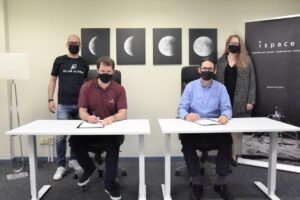
Spanish-German startup Plus Ultra Space Outposts plans to deploy the bulk of its proposed lunar communications and navigation constellation with ispace, the Japanese lunar transportation venture selling accommodations on its moon-bound landers.
ULA launches two space surveillance satellites for U.S. Space Force
Friday, 21 January 2022 18:17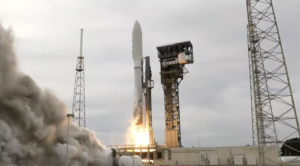
In its first mission of 2022, a United Launch Alliance Atlas 5 rocket on Jan. 21 launched a pair of space-monitoring satellites for the U.S. Space Force.
ExoMars on schedule for September launch
Friday, 21 January 2022 17:27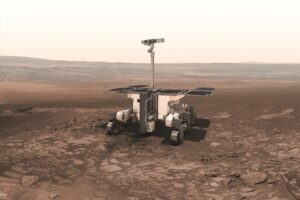
After missing its initial launch window in 2020 in part because of the pandemic, the European Space Agency’s ExoMars mission is on schedule for a launch in September.
Mid-level flare erupts from sun
Friday, 21 January 2022 16:46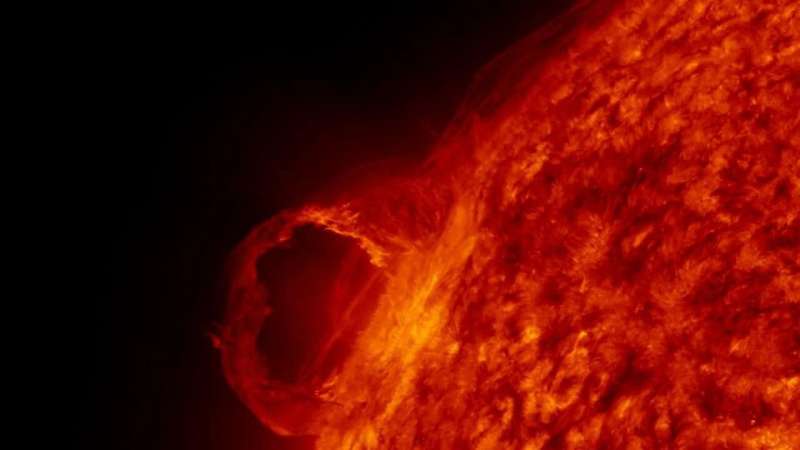
The sun emitted a mid-level solar flare on Jan. 20, 2022, peaking at 1:01 a.m. EST. NASA's Solar Dynamics Observatory, which watches the sun constantly, captured an image of the event.
Solar flares are powerful bursts of energy. Flares and solar eruptions can impact radio communications, electric power grids, navigation signals, and pose risks to spacecraft and astronauts.
This flare is classified as a M5.5 class flare.
Explore further
NOAA's Space Weather Prediction Center: spaceweather.gov/
NASA emergency beacons save 330 lives in 2021
Friday, 21 January 2022 16:35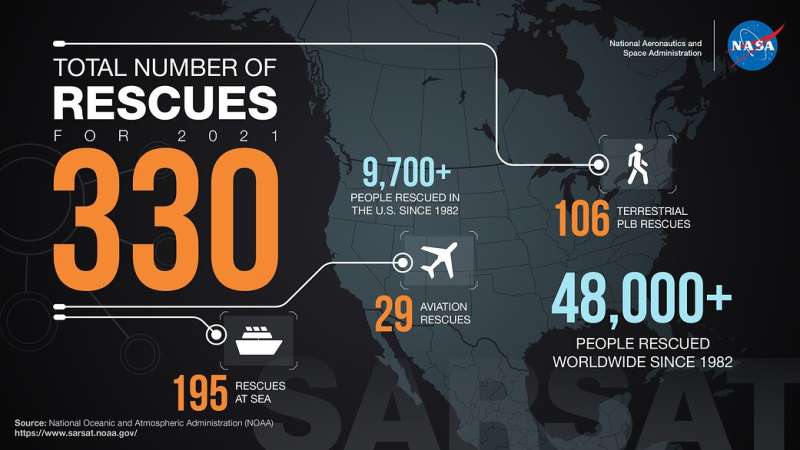
In 2021, NASA technology saved 330 lives in the U.S. network region of the international satellite-aided search and rescue effort, Cospas-Sarsat. NASA has lent technical expertise to the Cospas-Sarsat program since its founding, aiding in the rescue of over 48,000 individuals globally.
Users purchasing commercially available 406 MHz frequency Cospas-Sarsat beacons have free access to the network, which provides accurate and reliable emergency location services. When users activate these beacons, they send signals through satellite instruments to ground stations that can calculate their position. The network then alerts first responders to the location and nature of the emergency.
Beacons are available in three types: Personal Locator Beacons (PLBs), for use by hikers and other explorers; Emergency Position Indicating Radio Beacons (EPIRBs), designed for maritime use; and Emergency Locator Transmitters (ELTs) for aviation. In 2021, 106 rescues were PLBs, 195 were EPIRBS, and 29 were ELTs.
In recent years, NASA's Search and Rescue (SAR) office has helped Cospas-Sarsat to enhance its network with aviation studies, next-generation beacon technology, and new capabilities for Artemis astronauts. The office is also working on a lunar search and rescue concept, or LunaSAR, as part of NASA's lunar network development effort, LunaNet.
Former NASA administrator Bridenstine endorses candidate in Virginia congressional race
Friday, 21 January 2022 16:00
Former NASA administrator Jim Bridenstine is wading into one of Virginia’s congressional races, backing a Republican candidate with a background in national security space.
NASA's TESS hits milestone of 5,000 exoplanet candidates
Friday, 21 January 2022 14:14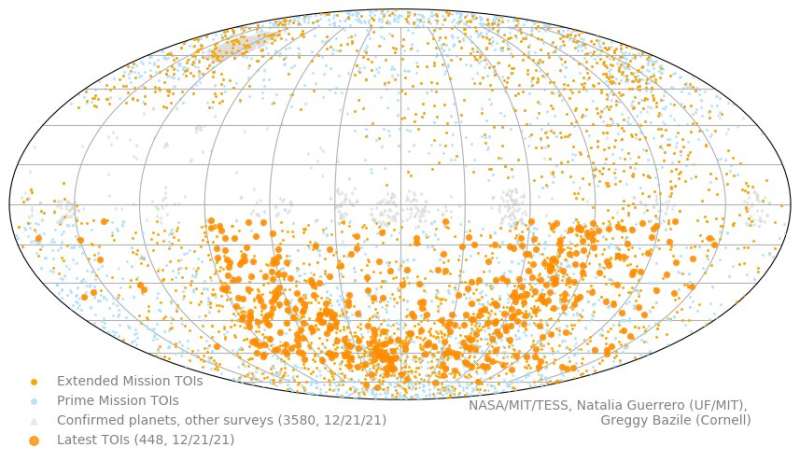
The catalog of planet candidates found with NASA's Transiting Exoplanet Survey Satellite (TESS) recently passed 5,000 TOIs, or TESS Objects of Interest.

